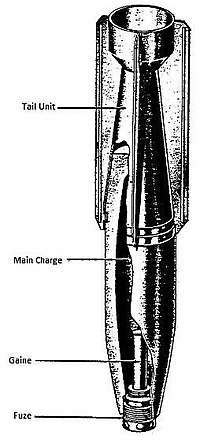SD 15 (bomb)
The SD 15 (Sprengbombe Dickwandig) or thick walled explosive bomb in English was a fragmentation bomb used by the Luftwaffe during World War II.
| SD 15 | |
|---|---|
 | |
| Type | Fragmentation bomb |
| Place of origin | |
| Service history | |
| Used by | Luftwaffe |
| Wars | World War II |
| Specifications | |
| Mass | 15 kg (33 lb) |
| Length | 61 cm (2 ft) |
| Diameter | 105 mm (4.1 in)[1] |
| Warhead | TNT |
| Warhead weight | 4.07 kg (9 lb)[2] |
History
The second most used category of bombs was the SD series which were high-explosive bombs but with thicker casings which meant their charge to weight ratio was only 30 to 40% of their total weight. Bombs in this series were the SD 1, SD 1 FRZ, SD 2, SD 10 A, SD 10 FRZ, SD 10 C, SD 15, SD 50, SD 70, SD 250, SD 500, SD 1400, and SD 1700. The number in the bombs designation corresponded to the approximate weight of the bomb.[3]
Design
The body of the SD 15 was of one piece cast steel construction and was a conversion of high-explosive projectiles used by the 10.5 cm leFH 18 howitzers of the German Army. The bomb was filled through the nose with TNT and was internally threaded for a nose fuze. The tail cone was composed of four sheet steel sections that were welded together and crimped into an annular groove machined in the rear 1/3 of the projectile. The SD 15 was used as a sub-munition and 24 could be carried by the AB 500-1D cluster bomb. The body was painted dark green with a khaki colored tail.[1]
References
- United States War Office (1953). German explosive ordnance : (bombs, fuzes, rockets, land mines, grenades and igniters). United States Government Printing Office. OCLC 713755660.
- United States. Department of the Army (1953). German explosive ordnance (projectiles and projectile fuzes). U.S. G.P.O. OCLC 56667468.
- Visingr, Lukáš. "Německé letecké bomby: Smrticí arzenál Luftwaffe". Vojsko.net (in Czech). Retrieved 2019-03-07.